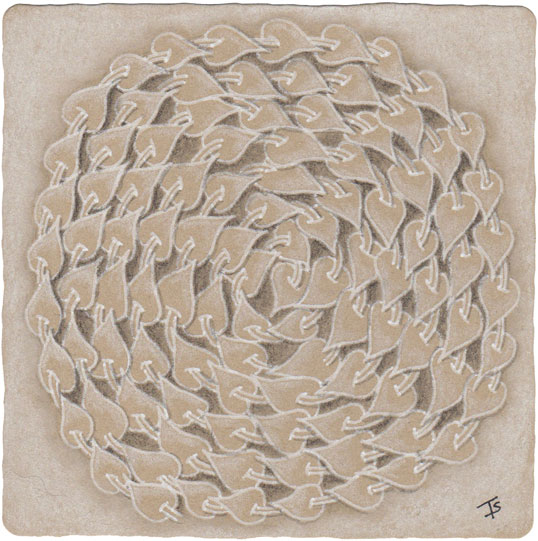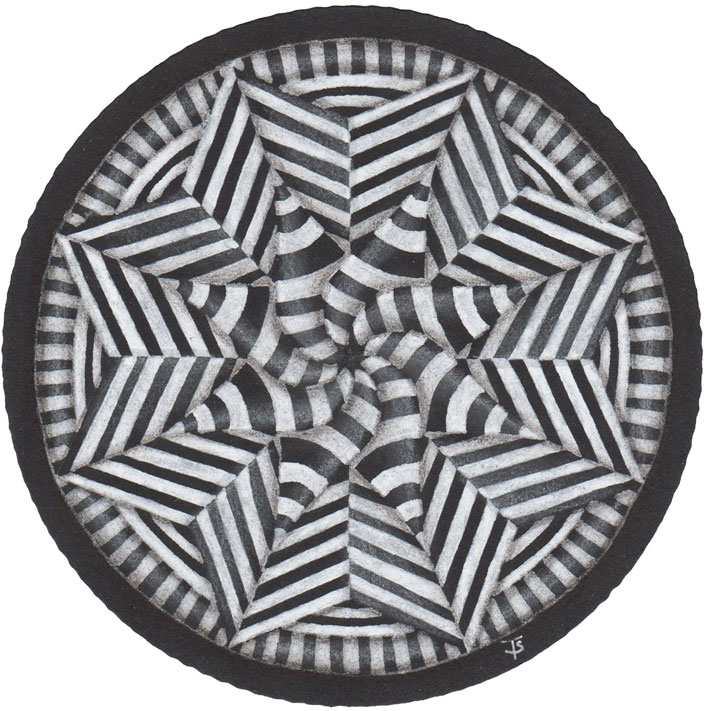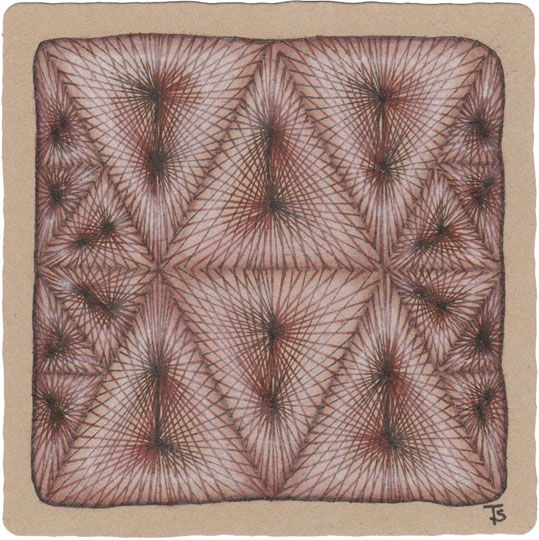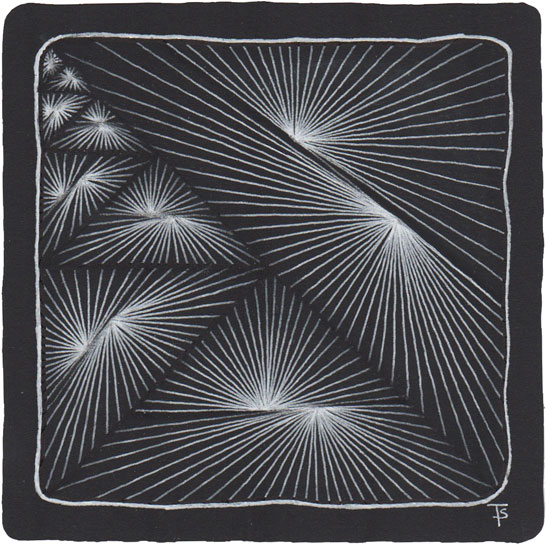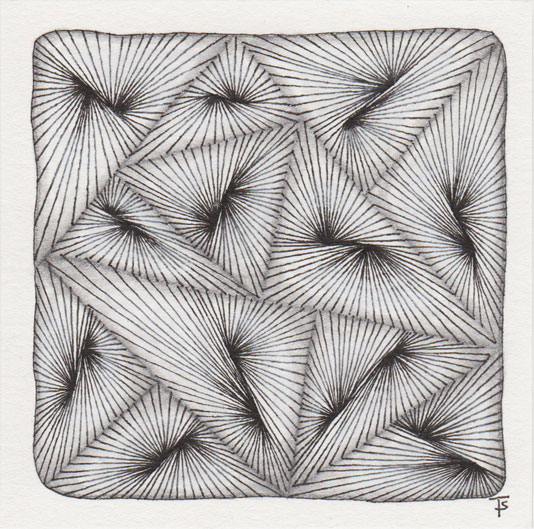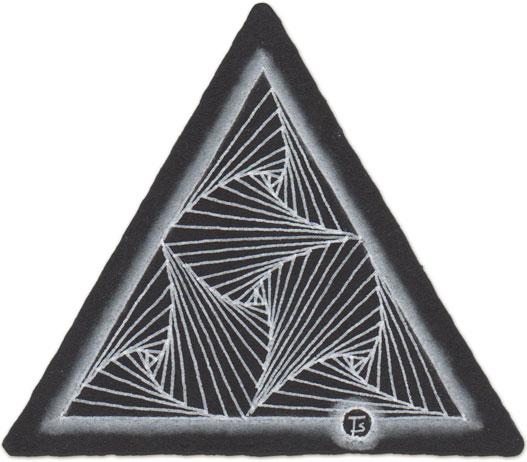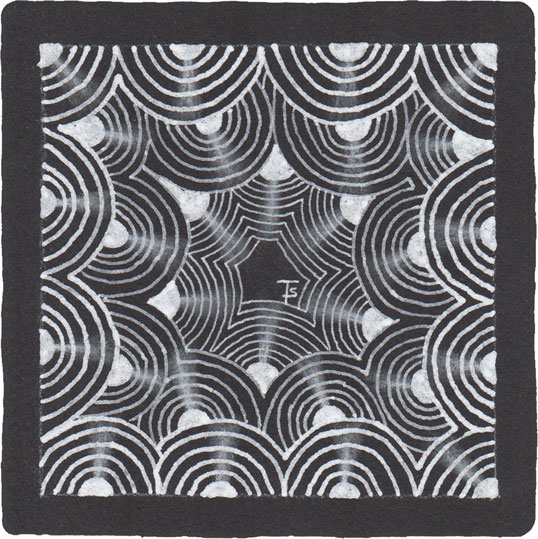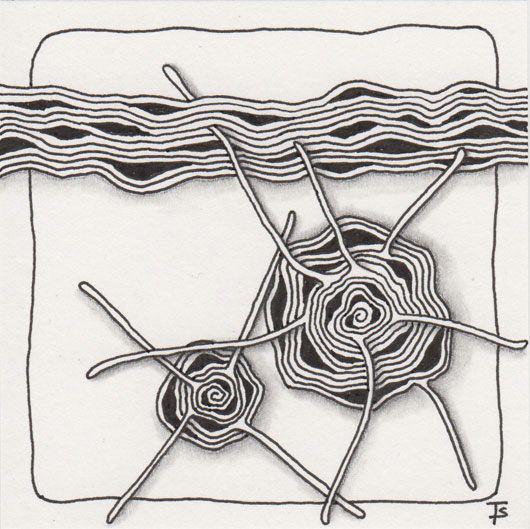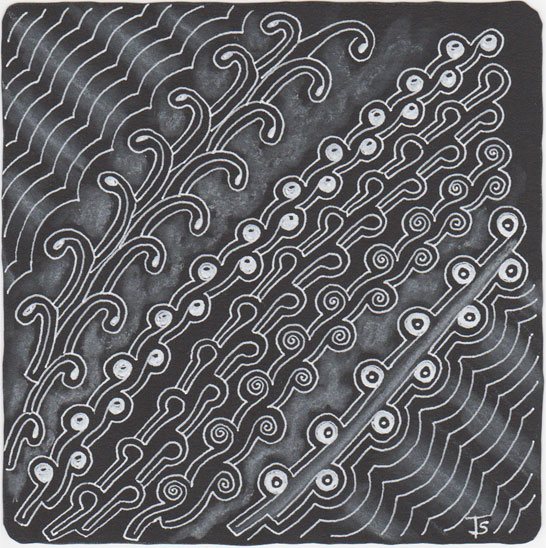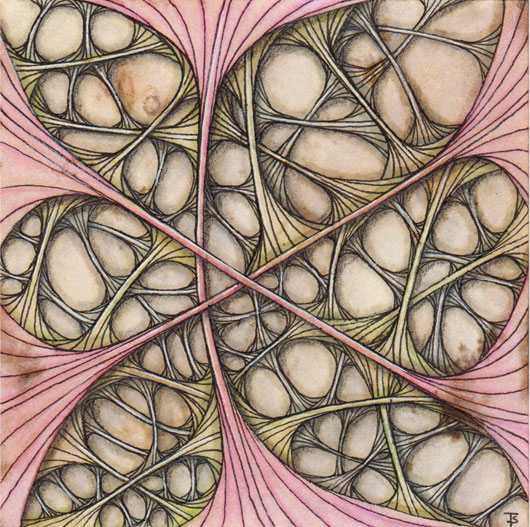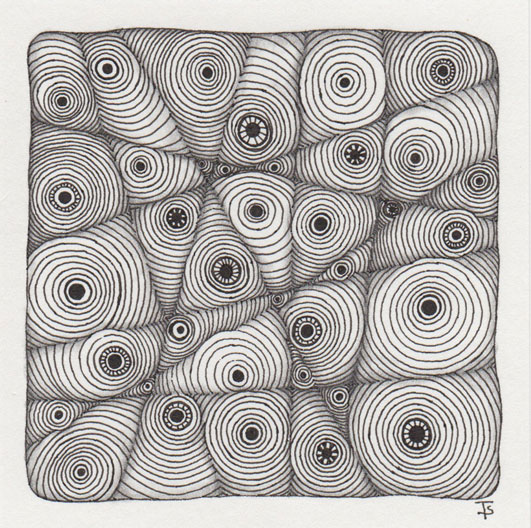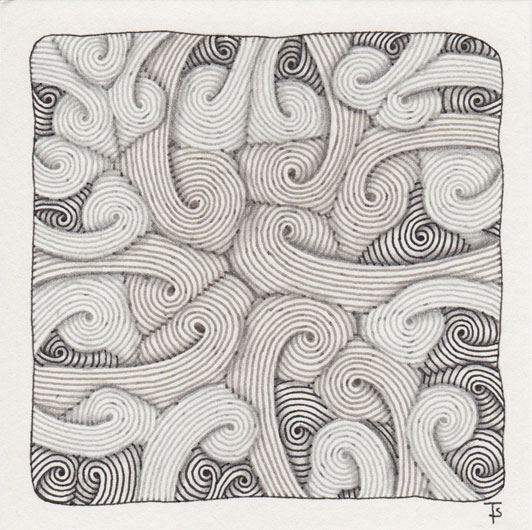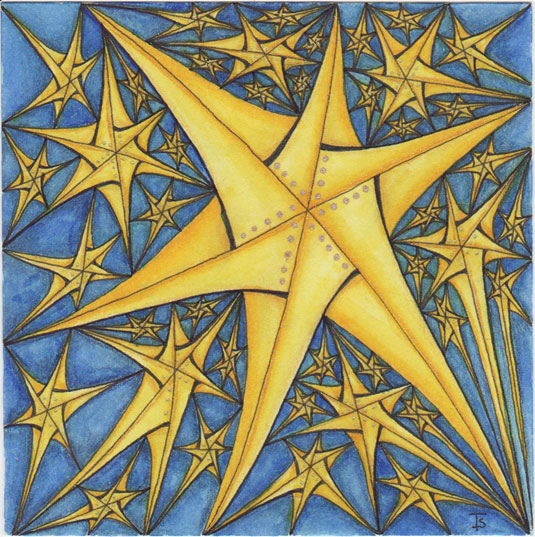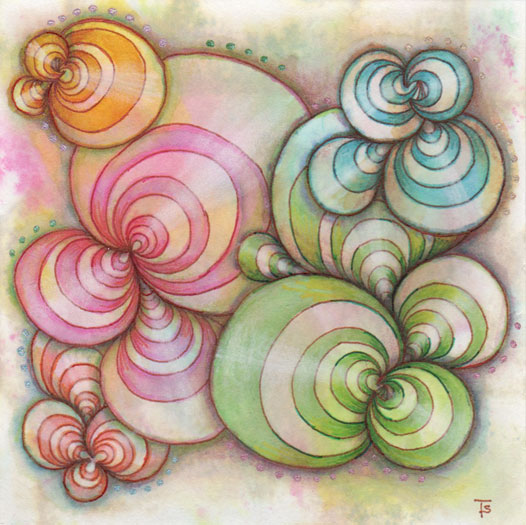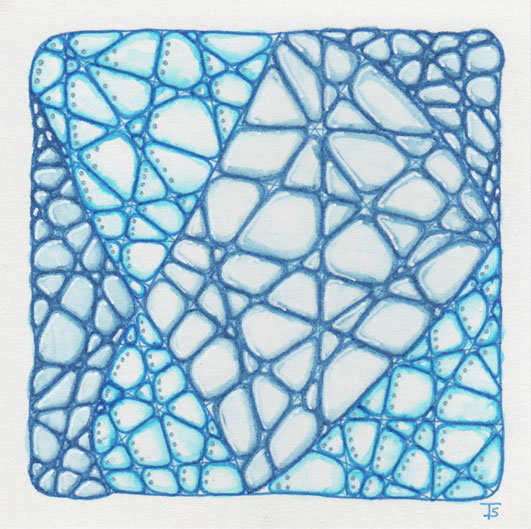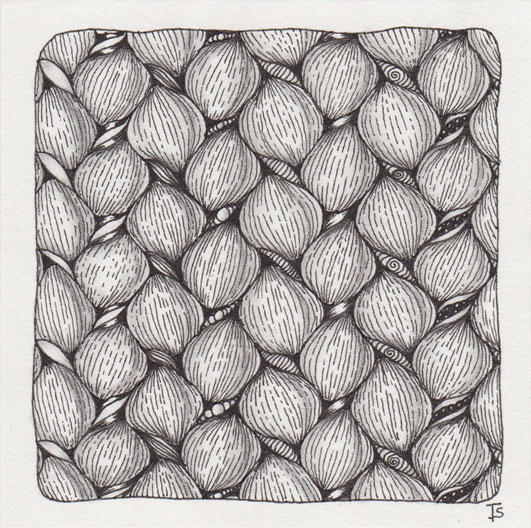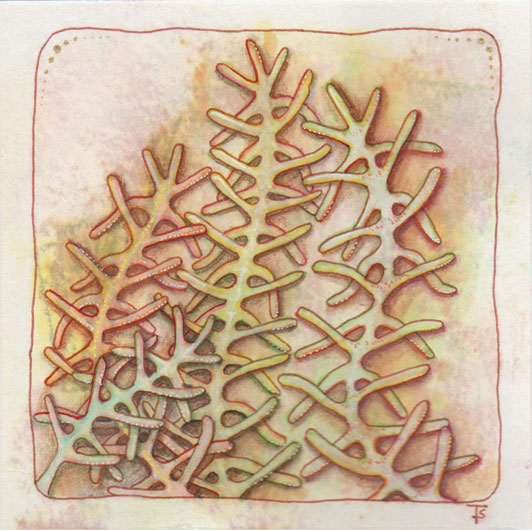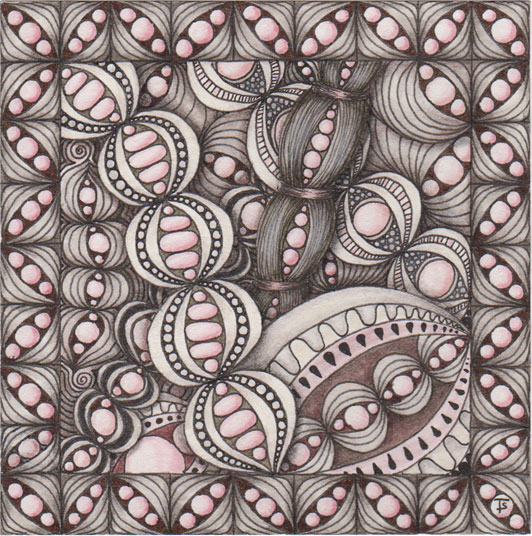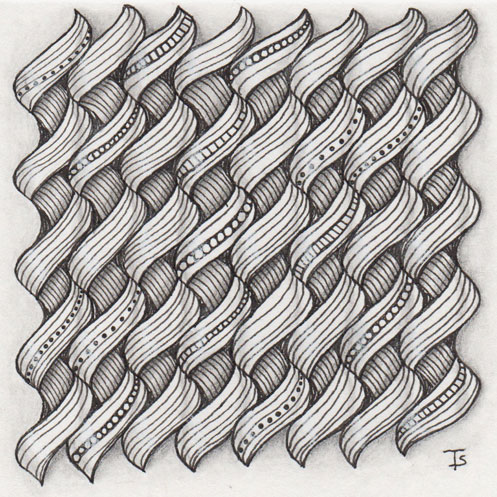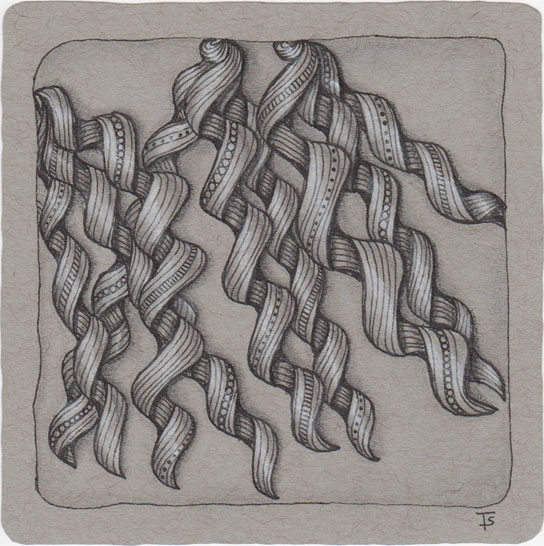This is actually the second-to-last of the Project Pack 1 series, but I saved it to do last. Unlike the other projects in this series, this one is done on a tan tile. In the video Maria shows us her daughter’s beautiful photograph of pumpkin seeds that have arranged themselves into a spiral. It was the inspiration for this exercise, where we are using Pokeleaf, drawn in a spiral pattern.
This monotangle Zendala is from Project Pack 1. In the video , Molly tells us that the pre-strung zendala in each pack was chosen at random, so there were several different designs. I didn’t have a pre-strung tile, so I copied the string from the tile at the beginning of the video.
This is the second Zendala tile that I’ve drawn on. For this one, the bigger size didn’t bother me.
I thought it might be interesting to do an overlapped version of Irradial on a tan tile using brown and sepia ink.
As I did the first, brown lines, the pen was very juicy and made a large brown blog where all the lines converged. I wasn’t totally happy with it, but I decided to continue.
Then, the sepia pen was very dry, making light, almost sketchy lines and almost no blog at the convergence.
Here is Irradial done on a black tile, with a bit of fractalization. Again, I wanted to keep the string simple so that I could just enjoy drawing the tangle. I also wanted to experiment with using Copic markers to shade around each section. It didn’t quite get as dark as I wanted, so then I added black charcoal pencil around the borders and at the center line for each section.
This awesome tangle, Irradial, created by Thomas Padros is the focus tangle for this week in couple of Facebook groups! For my first attempt, I just wanted to keep it fairly simply so my string is just a bunch of triangles. I tried to vary the centers of each one somewhat by rotating the starting point, or making it closer to one edge than another.
The shading and highlighting is subtle, but it still adds a lot of dimension and shape to each section.
This is my first, official, 3Z (triangular shaped) Zentangle. These tiles are 3-1/2 inches on a side. That makes the overall drawing area smaller than a standard tile.
I did this following the video here , for Project Pack 1. I’m beginning to warm up to these black tiles. I found doing this one fun! Part of it is the design. It was easy, calming, and I really love the results!
When you are learning to tangle, Crescent Moon is one of the first that you learn. It teaches the concept of creating an “aura” near something that has already been drawn. Auras are frequently used to build repeating designs or to add emphasis or separation.
This Zentangle is from Project Pack 1.
Zentangle drawn on a black, Official Zentangle tile using three different sizes of white, Sakura gel pens. Highlighting done with white charcoal pencil.
This tile is from Project Pack 2, The Twelve Days of Zentangle. On day four we are doing a twist on Diva Dance. Here, you see it drawn both as a ribbon and as a spirals (Diva Dance rock-n-roll.) However, a new technique has been added. It looks as if the tangle has developed arms. Rick refers to these as “sproings!” You can learn all about them by watching the video, here .
On the second day of Project Pack 1, a new tangle was introduced: Dewd. This is a fun tangle that can be used as a fill or a ribbon. You can watch the video for this exercise here .
Since I had already done a couple of tiles incorporating Dewd ( here and here ,) I just wanted to do something simple. I decided to see how many variations I could come up with for Dewd.
I combined several different techniques on this tile. I didn’t start out to make a Monotangle. Originally I was going to put a bunch of different tangles in the spaces between the largest Ruutz. But I just got into the zen of it and fractalized Ruutz down three iterations.
Then I decided to color the various levels. The top level I colored pink, the second was a lime green, and the smallest was a light blue-violet.
Watchers.
They were part of the fabric of the planet. The watchers were everywhere she had been. In the buildings, they incorporated themselves into the corners and between the cornices. In the gardens, they often were at the heart of a blossom or hidden in the fold of a leaf. Even on the shorline, she found them nestled among the rocks. If one wasn’t diligent, one might even find them in the porridge or bread.
Swirls.
Am I looking down at a carpet? A muddy river? Foam at the edge of a wave on the beach? It’s an interesting, visual mystery!
Sand Swirl is one of my favorite tangles to draw. It’s simple echoed lines allow your mind to enter the Zen zone quickly. Here, I used three different colors of ink to give the tile more depth and dimension.
Zentangle drawn on Strathmore Vellum Bristol using a black, Micron pen, warm grey and cool grey Copic Multiliner.
Fractalized stars.
Recently, Eni Oken added a lesson about fractalizing tangles to her Art Club members. It was a fantastic lesson and everyone had a lot of fun creating beautiful tiles.
I decided to try Betweed for my tangle because it looks like a star to me, and I love anything having to do with stars! The “rule” I used was to draw a new, smaller Betweed in each space created by the original rendition.
Mutant disks.
Bunzo looks like a cross between striped Frisbees and amoebas. It’s as if the plastic disks are replicating by division!
I decided to make each section a different color, according to the most prevalent color in that particular area of the tile. I was a little worried because there were so many colors, but I think, in the end, it all came together and worked out well.
Crazy.
For this Zentangle, Nzepple has taken a walk on the wild side! This is referred to as Crazy Nzepple. I just wanted to do something simple and claming, and this fit the bill. I chose blue because it is the color of water and sky. It is soothing and calming. I added the gel pen accents, both the metallic blue dots and the white highlights to give the tile more dimension.
In-between.
It’s what lies between that makes the difference.
This is actually a Monotangle, meaning only one tangle pattern was used on the entire tile. I normally post Monotangles on Mondays, but I had something special to post yesterday, so this is being posted on Tuesday, instead.
I chose African Artist because it is a pattern that has been difficult for me to execute. For one thing, sometimes I get the little portions going in the wrong direction.
Succulents.
When you group a bunch of Locar tangles together they look a bit like cactus or succulents!
The techniques that I used on this tile are based on Eni Oken’s Distressed Tile Video . However, I didn’t follow the instructions exactly. (It’s probably a good thing I wasn’t baking a cake!) I already had this tile on my desk, with the Locars already drawn on it in brown pigma pen.
Pods.
Today’s monotangle is brought to you by the Svalbard Global Seed Vault . If you don’t know anything about it, you should. You can go an a virtual tour of the vault via your own compter, without even leaving home by clicking here. The tangle Inapod has always been one of my favorites. I love the way the lines flip back and forth as it is drawn and how the pods emerge as you draw.
Calm.
Where I live, we have monsoon rains in the Summer. Generally, what that means is that, when it rains, it rains hard! There’s lots of wind before and during the storm and also lots of lightning. And it can be almost impossible to sleep.
This simple, all-over pattern of Pea-nuckle was created during a real humdinger of a storm late at night! We got over an inch of rain in about an hour.
Ribbons.
I have a new go-to tangle that I love: Pea-nuckle. Here, I’ve used it to make sets of curled ribbons. Originally, I didn’t much care for this particular tangle. I often threw it back in the jar when it came up randomly. Not any more, though. I watched Eni Oken’s Art Club video for a different way of drawing this tangle. And now, I love it!
I’m also in love with this gray-toned paper!
